Alcatel-Lucent 4074 H, 4074 GH, 4074 GI, 4074 GB, 4074 CC User Manual
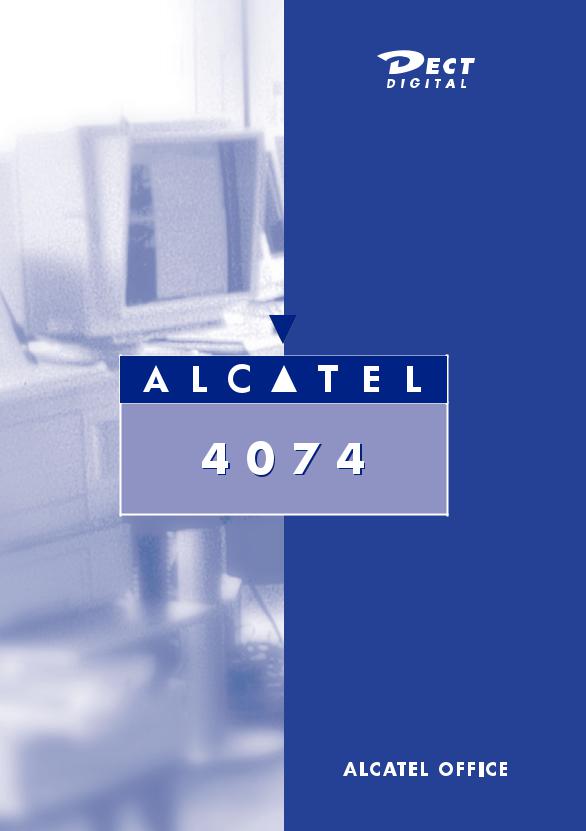

 User guide
User guide
You now have a cordless telephone (model 4074 B, 4074 GB, 4074 CC, 4074 GI, 4074 H or 4074 GH). Your telephone complies with DECT standards and is one of the Alcatel ReflexesTM range.
To help you become immediately operational, we have prepared an easy-to-use guide.
In easy steps, you will get to know the many functions provided by your telephone, from the simplest, which you will learn immediately, gradually progressing to the most complex, including all the “convenience” functions.
Your Alcatel 4074 will provide all you want and expect from a telephone.
The availability of some of the functions described may depend on your model of telephone, or on your system version or configuration. If you are in doubt, consult your system supervisor.
1
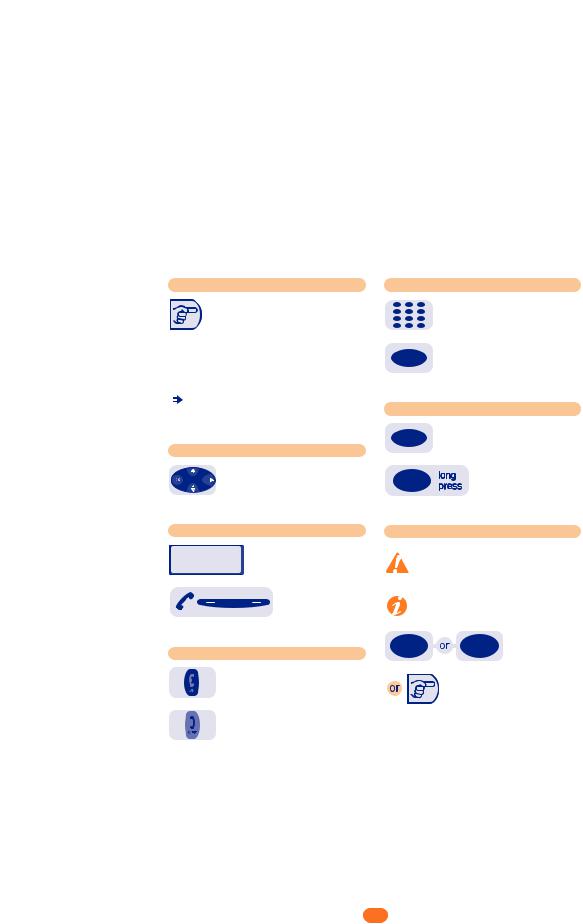
 Symbols used
Symbols used
in the documentation
Actions, events
Press. |
|
|
|
Text on blue |
Description of an action |
background. |
or context. |
|
|
Indicates result of action.
Navigation key
The navigator has four keys. The appropriate key will be highlighted.
Keypads
Alphanumeric keypad.
Specific key on alphanumeric keypad.
Function and multi-function keys
First function.
Second function.
Display and display keys
Display
Line key and corresponding icon
Line keys
Lift receiver, take line.
Hang up, terminal inactive.
Other symbols used
Important information.
Comment.
Choice of two keys
Alternative to action sequence.
Choice of operating mode in an action sequence.
2

Contents
............................................................................Your telephone |
p. 5 |
|
|
||
Principles of utilisation, using your telephone, cleaning your |
|
|
telephone, installing the battery in the telephone. |
|
|
Accessories |
p. 13 |
|
|
||
Charger/holders, spare battery, using the commercial battery |
|
|
holder, carrying bag. |
|
|
Using your telephone |
p. 19 |
|
|
||
Making an outside call, making an internal call, calling an internal |
|
|
correspondent by name. |
|
|
Handling several calls |
p. 27 |
|
|
||
A second call while a call is in progress, receiving a second |
|
|
call while a call is in progress. |
|
|
Group operation |
p. 33 |
|
|
||
Answering a general bell, call pick-up, |
|
|
hunting groups. |
|
|
While you are away - When you return |
p. 37 |
|
|
||
|
||
Selecting calls to be diverted, diverting calls to another number, |
|
|
diverting calls to a recorded message. |
|
|
Customizing and adjusting your telephone |
p. 43 |
|
|
||
Adjusting your telephone, programming your personal code, |
|
|
selecting your ringer tune, selecting receiver sound volume.. |
|
|
Using your telephone in GAP mode |
p. 49 |
|
|
||
Registering the telephone, customizing your telephone, |
|
|
programming your personal directory, using your telephone. |
|
|
Glossary |
p. 57 |
|
|
||
Index |
p. 59 |
|
|
||
3 |
|
|
|
|
|
|
|
|

4

1
...................................................................................................................General description |
p. 6 |
|
|
||
Principles of utilisation ............................................................................................................ |
p. 8 |
|
Conditions of utilisation of your telephone.................................................................. |
p. 8 |
|
Using your telephone............................................................................................................... |
p. 9 |
|
Cleaning your telephone........................................................................................................ |
p. 10 |
|
Carrying your telephone......................................................................................................... |
p. 10 |
|
Locking your telephone keypad ......................................................................................... |
p. 10 |
|
Screen backlighting .................................................................................................................. |
p. 10 |
|
Beeps other than during calls............................................................................................ |
p. 11 |
|
Installing the battery in the telephone............................................................................ |
p. 11 |
|
5
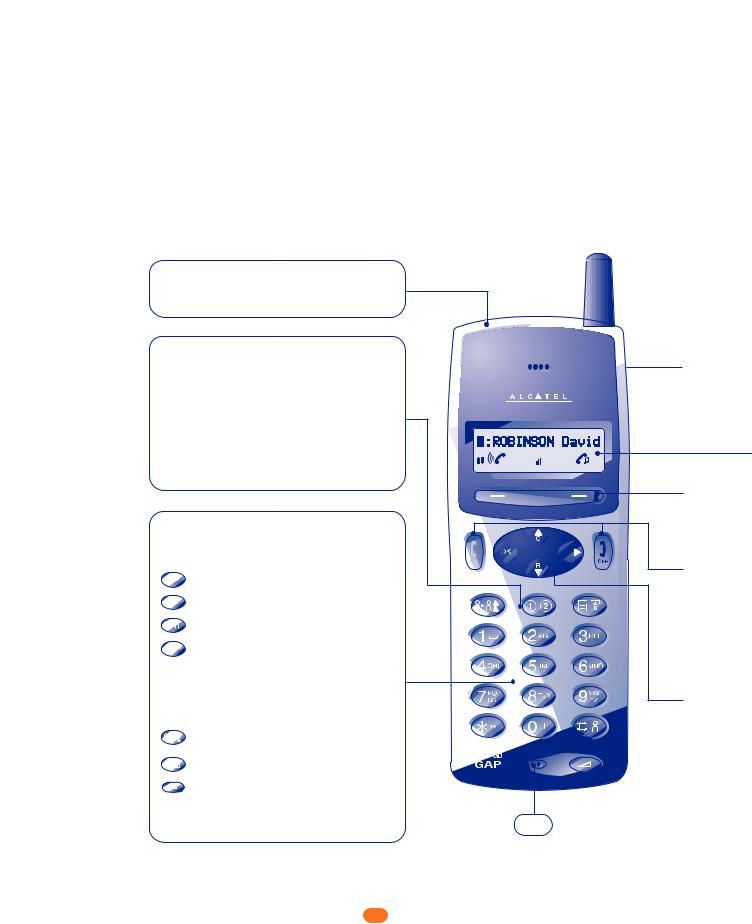
 Your telephone
Your telephone
Green light indicating:
Incoming call: flashing with call ringing. Going out of radio coverage: fast flashing.
Programmable keys
Your telephone has two keys that can be programmed by the installation technician.
The keys are used to:
 make a direct internal or external call
make a direct internal or external call
 access a function
access a function
By default:
 Conference
Conference
 Message service (long press)
Message service (long press)
Function keys: |
|
The function is obtained by a long press |
|
on the key (2 beeps). |
|
Sending DTMF codes (long press). |
|
Customizing your telephone (long press). |
|
Adjusting your telephone (long press). |
|
Activating the buzzer while deactivating |
|
the ringer, and vice-versa (long press). |
|
Multi-function keys: |
|
The first function is obtained by a quick press |
|
(1 beep) and the second function by a long |
|
press (2 beeps). |
|
Transferring a call |
|
Redialling the last number dialled (long press). |
|
Personal directory. |
|
Call by name (long press). |
|
During a call: adjusting earphone sound |
|
volume. |
|
In standby: locking/unlocking your keypad, |
|
4074 GI backlighting on/off (long press) |
Micro |
6
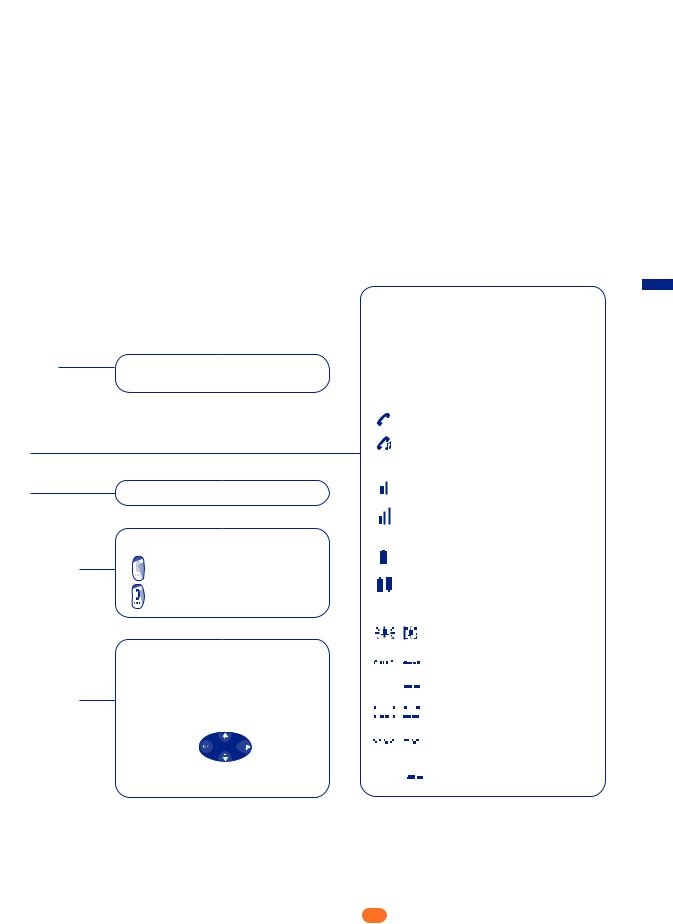
 Your telephone
Your telephone
Headset socket:
(models 4074 H, 4074 GH and 4074 GI)
Line key
Display and corresponding icons:
Comprises 2 lines of 16 characters.
The first line gives general information and the second shows the icons corresponding to the function keys:
Call icons:

 Incoming call.
Incoming call.
Call in progress.
Placing a call on hold.
Radio reception icons:
Limit of coverage zone (flashing).
Poor reception (light on).
Reception OK (light on)
Call keys:
Lifting the receiver.
Switching on (long press).
Hanging up or end of entry.
Switching off (long press).
Navigator:
Display pages can be scrolled, to confirm entries:
Display previous choice.
Erase last character entered.
Validate entry |
Scroll the |
or initiate a call |
display |
by name. |
pages. |
Display next choice in list or send timed break (depends on context).
Battery icons:
Battery discharged or defective (flashing).
Battery on charge (flashing).
Battery fully charged (light on).
Option icons:
Ringer on/off. |















 Key beeps on/off.
Key beeps on/off.




 Volume (1 to 4).
Volume (1 to 4).















 Going out of coverage beeps on/off.
Going out of coverage beeps on/off.
Buzzer on/off (on 4074 GC 












 and 4074 GI).
and 4074 GI).






 Ringer volume (GAP mode).
Ringer volume (GAP mode).
7

 Your telephone
Your telephone
Principles of utilisation
 Coverage zone:
Coverage zone:
The DECT functions provided by your Alcatel system basically allow user mobility by managing DECT cordless telephones..
The Alcatel system radio coverage is provided by a number of base stations that transmit and receive within a radius of 20 m to 50 m (depending on environment).
The zone covered by a base station is called a cell.
 Mobility:
Mobility:
A user can make or receive calls in any cell.
 Radio transfer:
Radio transfer:
Radio transfer allows the user to move around, from one cell to another, during a call. Transition between cells is automatic, with no effect on the call. In some cases,
a slight crackle may be audible at the instant of transition.
Conditions of utilisation of your telephone
 Using a DECT standard telephone:
Using a DECT standard telephone:
You are going to use a DECT standard telephone that provides a private call facility between cordless telephones and a cordless PBX or domestic relay units.
 Conditions of utilisation:
Conditions of utilisation:
In addition to the actual equipment type approval, the conditions of utilisation must als be observed, notably concerning the radio frequencies used:
No guarantee is given concerning possible interference affecting DECT equipment, due to other authorised utilisation of the radio frequencies concerned.
DECT equipment must not be used to provide telephone links between fixed points, as the links are not permanent and the power radiated by the antenna
is less than 250 mW.
DECT systems must be installed by a licensed technician.
8
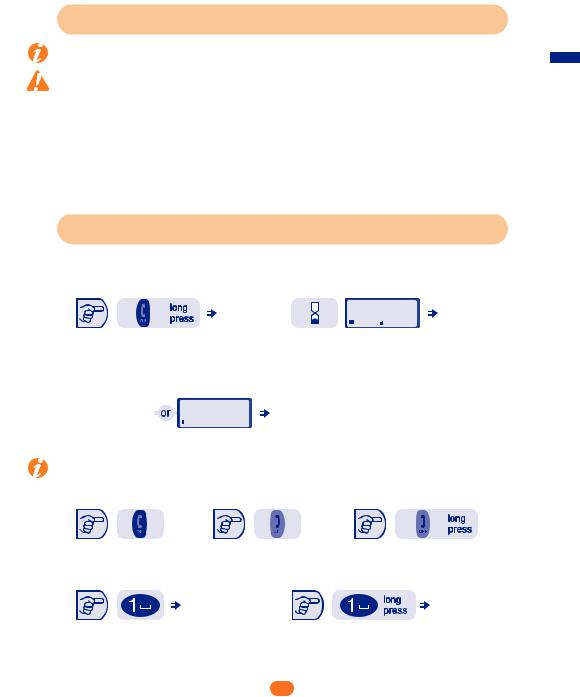
 Your telephone
Your telephone
Conditions of utilisation of your telephone (continued)
This telephone must only be used with an Alcatel system.
Do not expose your telephone to severe |
such as rain, salty spray, dust, |
etc, which can adversely affect operation |
|
Your telephone may not operate properly |
temperatures below -20°C |
or above +55°C. |
|
Between -5°C and -20°C the display |
be readable but this is only temporary |
and does not affect the operation of y |
. |
Do not use your telephone close to inflammable gas or liquids.
Using your telephone
Charging the telephone on its holder |
15). |
|
|
|
|
|||||
Switching on your telephone: |
|
|
|
|
|
|
||||
|
|
|
|
|
|
|
|
|
|
|
|
|
|
|
display |
|
|
|
|
|
your telephone |
|
|
|
|
comes |
|
|
|
|
|
is operational |
|
|
|
|
one beep |
|
ait a few battery and coverage |
||||
|
|
|
|
|
|
icons light up |
||||
Conversely, if: |
|
|
|
|
|
|
|
|
||
|
|
|
|
|
|
|
|
|
|
|
|
the display does |
|
|
|
|
charge |
|
|
|
|
|
not come on |
|
|
|
|
the battery |
|
|
|
|
|
|
|
icon flashing |
|
|
|
|
|
|
|
|
|
|
|
|
|
|
|
|
||
|
If the display shows “OUT”, you are |
|
the coverage zone. |
|||||||
Lifting the receiver: |
Hanging up: |
|
Switching off your telephone: |
|||||||
Keys with a dual function: |
|
|
|
Left-hand function: |
-hand function: |
||
|
|
|
|
|
one |
|
a second beep |
|
beep |
|
(lower tone) |
|
|
|
|
short press |
at least one second |
||
9
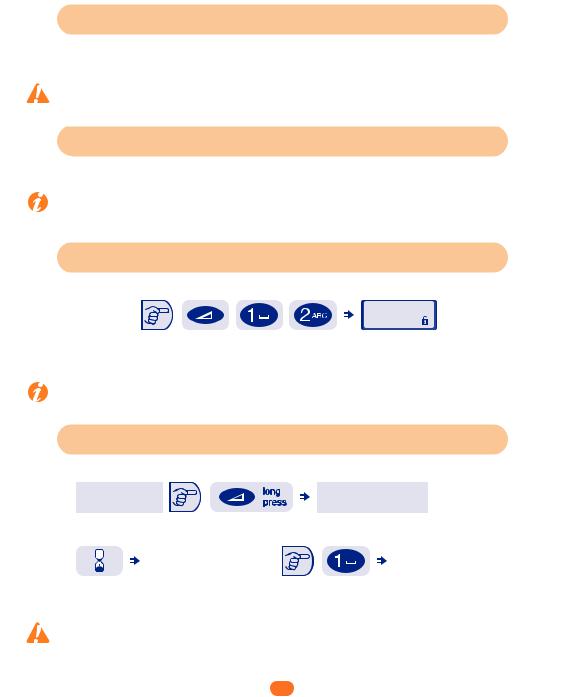
 Your telephone
Your telephone
Cleaning your telephone
Your telephone does not require any specific servicing. However, it may be cleaned using a soft, damp cloth.
Do not use soap or detergent, which could damage the colours or surfaces of the telephone.
Carrying your telephone
To avoid losing your telephone, get
The casing of telephones 4074 H, protection against impact. Various Consult your installation technician.
Locking your telephone keypad
habit of clipping it onto your belt.
and 4074 GI provides protective case are available.
To prevent the keys from being |
pressed: |
||
|
|
|
|
|
in standby |
|
|
|
|
|
keypad is locked |
|
|
|
|
Proceed in the same way to unlock the |
. |
||
The keypad is unlocked automatically |
call is received and locked again |
||
after the call. |
|
||
Screen backlighting*
Allows the telephone to be using in
a call is in progress or telephone
in standby
conditions:
-in standby: 2 beeps
-call in progress: no beep
When you stop pressing the keys: |
you press a key again: |
|||
|
|
|
|
|
|
lighting goes out |
|
|
lighting lights up |
|
automatically |
|
|
automatically |
|
|
|
|
|
15 seconds
Proceed in the same way to deactivate backlighting.
Using this function as little as possible |
the time between battery charges. |
* Backlighting provided for display and keys on telephones 4074 H, 4074 GH and 4074 GI.
10
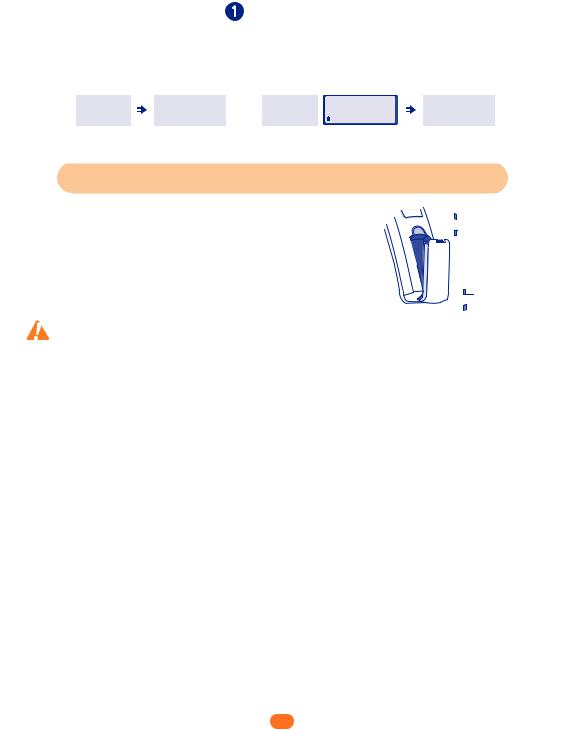
|
|
Your telephone |
|
|
|
|
|
|
|
|
|
Beeps other than during calls |
|
|
|
|
|
|
|
|
|
|
|
Coverage beeps: |
|
Battery charge beeps: |
|
|
|
|
you are going |
|
battery needs |
|
|
|
|
|
|
||
2 beeps |
out of |
4 beeps |
|
|
|
|
|
|
|||
coverage
charging
icon flashing
Installing the battery in the
 2
2
Do not use excessive force. Insert the |
part (1) |
first, and then gently press the upper |
(2) to click |
into position. |
|
 1
1
Do not force the battery insertion as damage your telephone.
11

12

2
Charger/holders.......................................................................................................................... |
p. 14 |
|
Batteries........................................................................................................................................... |
p. 14 |
|
Charging your telephone ....................................................................................................... |
p. 15 |
|
Charging the spare battery |
p. 16 |
|
|
||
Using the commercial battery holder............................................................................. |
p. 16 |
|
Carrying cases............................................................................................................................. |
p. 17 |
|
13
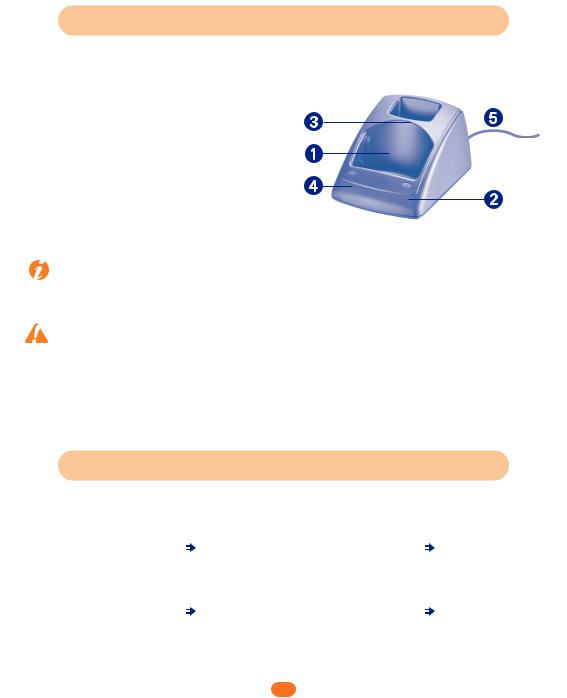
 Accessories
Accessories
Charger/holders
 Support 4071 DA :
Support 4071 DA :
Charger/holder 4071 DA provides a convenient holder for the telephone while also charging the battery. The telephone can be “off” or “on”.
The holder comprises:
1.a position for the telephone,
2.an LED indicating the battery charge level,
3.a position for a spare battery,
4.an LED indicating the level of charge
of the spare battery,
5. a mains power connection cable.
The fully charged indications given on the telephone display and
on the charger can differ by one or two minutes. This has no influence
on the battery charge level. If the telephone is placed on the holder 4071 DA without a battery, the battery charge LED indication will not be significant.
A wall mounting kit is available for your 4071 DA.
The mains power socket used must be close to the charger/holder and easily accessible, so that it can be used as an “on/off” facility.
 Holder 4071 BA and 4071 BC:
Holder 4071 BA and 4071 BC:
Two other models of charger/holder, with no spare battery position and no indicator LEDs (charge level is indicated on the telephone display), are also available as types 4071 BA and 4071 BC.
Charger/holder 4071 BC can be used with telephone 4074 GC to provide a hands free call facility.
Batteries
Your telephone is supplied with a 1200 mAh NiMh or a 600 mAh NiCd battery.
Endurance with NiMh battery:
in standby, inside the |
|
55 hours |
|
in continuous |
|
10 hours |
coverage zone |
|
|
conversation |
|
||
|
|
|
|
|
||
|
|
|
|
|
|
|
Endurance with NiCd battery:
in standby, inside the |
|
25 hours |
|
in continuous |
|
4 hours |
coverage zone |
|
|
conversation |
|
||
|
|
|
|
|
||
|
|
|
|
|
|
|
14
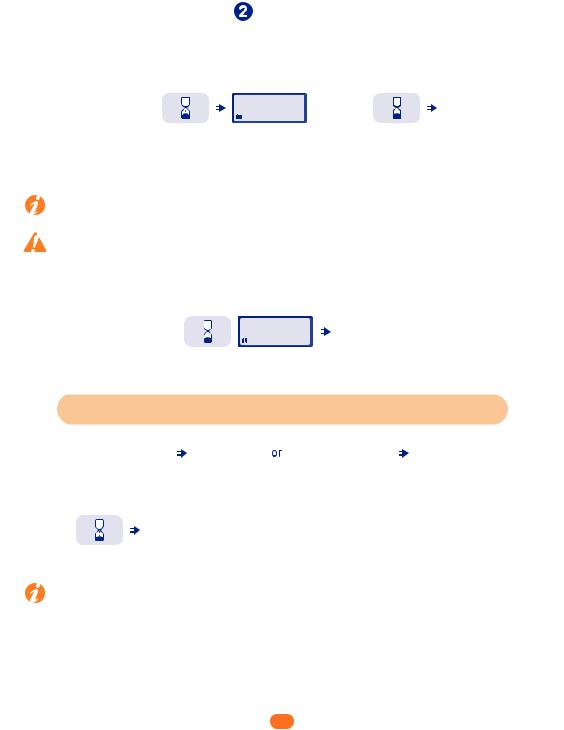
|
|
|
Accessories |
|
|
|
|
|||
|
|
|
|
|
|
|
|
|
|
|
Batteries (continued) |
|
|
|
|
|
|
|
|
||
|
|
|
|
|
|
|
|
|
|
|
Initial charge: |
|
|
|
|
|
|
|
|
||
|
|
|
|
|
|
|
|
|
|
|
place the telephone, |
|
|
|
|
battery |
|
|
|
||
|
switched off, |
|
|
|
charging |
|
|
|
|
|
|
|
|
|
|
charged |
|
|
|
||
|
on the charger |
|
|
|
|
|
|
|
|
|
|
|
|
|
|
|
|
|
|
|
|
|
|
5 minutes |
icon |
|
|
minimum 2 |
|
|
|
|
|
|
|
|
|
|
hours |
|
|
|
|
If no charge indication is displayed, |
battery alone in the rear housing |
|
|
|||||||
|
|
|||||||||
|
|
|||||||||
of the charger for at least two hours (overnight is recommended). |
|
|
|
|
||||||
Batteries only become fully efficient |
ten charge/discharge cycles. |
|
|
|||||||
The batteries contain polluting |
|
should be finally disposed of through |
|
|
||||||
a specialist collection point. |
|
|
|
|
|
|
|
|
||
Do not allow the battery to lose its capacity:
Each battery should be fully then charged, at least every two months:
do not place your |
|
give a complete |
telephone on |
|
|
|
charge |
|
the holder |
|
|
|
|
|
|
low |
|
|
is |
|
Charging your telephone
place the telephone |
|
the LED lights |
|
|
the LED lights up green |
|
|
|
|
|
|
and immediately |
|
quick charge phase |
|||
in the holder |
|
up red |
|
|
|
|||
|
|
|
becomes red |
|
|
|||
|
|
|
|
|
|
|
|
|
|
|
telephone fully |
|
telephone partially |
|
|||
|
|
discharged and off |
|
discharged, off or on |
|
|||
|
|
|
|
|
|
|
|
|
|
|
LED becomes green, |
|
|
|
|
||
|
indicating trickle charge |
|
|
|
|
|||
|
|
|
|
|
|
|
|
|
around |
telephone charged and av |
|
|
|
|
|||
90 minutes |
|
|
|
|
|
|
|
|
Do not needlessly remove/replace the telephone on its holder.
15
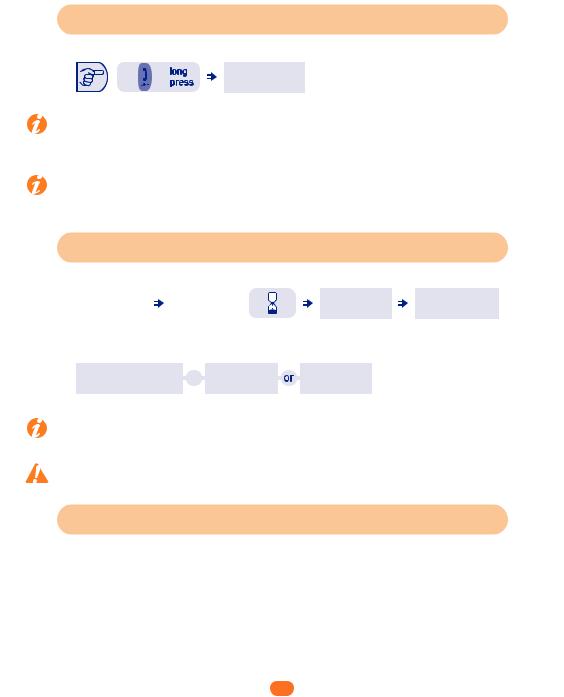
 Accessories
Accessories
Charging your telephone (continued)
Telephone not used for extended period (more than 8 days):
leave telephone on holder
If the telephone must be kept out of the |
, the battery should be removed |
and stored separately or placed in the spare battery housing on the rear |
|
of charger 4071 DA. |
|
When telephone 4074 GC is used in |
free mode, its battery is no longer |
charged. Avoid needlessly long conversations in hands free mode when the telephone battery is not fully charged. After a call hands free mode, charging the telephone will soon restore the full battery charge
Charging the spare battery
Install the battery, preferably fully discharged, in its housing:
the LED lights |
|
battery on slow |
up red |
|
charge |
|
|
|
8
Battery defective or incorrectly installed:
LED alternates LED does not light up  between green
between green
and red
LED becomes
battery OK for use
green
LED does not become red
The battery may become hot during the |
. This is not a fault. Protection is |
available against battery overheating, to preserve its nominal working life |
|
(only for an enclosed battery pack). |
|
The batteries contain polluting materials |
should be finally disposed of through |
a specialist collection point. |
|
Using the commercial battery holder
Depending on the model, your telephone package will contain a battery holder, enabling
ordinary commercial batteries to be used |
commercial AA NiCd 1.2 V battery may |
be used. However, the charge time |
will be at least 4 hours. |
To install the chargeable cells in the |
release the retaining strip, insert two AA cells, |
respecting the polarities shown inside |
holder, and install the retaining strip. |
You can now charge the holder, either installed in the telephone or in the charger spare battery housing.
16

 Accessories
Accessories
Using the commercial battery holder (continued)
Do not install different types of cell, or cells with different charge levels, in the holder.
Only batteries recommended by charged in the chargers supplied by observed, Alcatel declines all
Do not use dry batteries. Overcharging charge level and may seriously
be used. Batteries should only be If these instructions are not strictly
cannot increase the nominal telephone or charger.
Carrying cases
Several types of carrying case are av |
for the 4074 range of telephones. |
These cases provide effective |
impact (being dropped), dust and liquids. |
Carrying cases are strongly |
severe environments. For the characteristics |
of each model, contact your installation technician. |
|
Remove the belt clip from your |
facilitate case insertion and removal. |
To remove the belt clip from |
4 B, GB, GB Ex and GC, unscrew the clip |
mounting screw and store the belt clip |
future use. On telephones 4074 H, GH and |
GI, firstly release the belt clip using the |
a ball-point pen, while pushing back the |
top tab behind the clip. Then release |
by sliding it downwards on the telephone. |
17

18

3
Making a call ................................................................................................................................ |
p. 20 |
|
Making an outside call............................................................................................................ |
p. 20 |
|
Making an internal call ........................................................................................................... |
p. 20 |
|
Calling your correspondent by name |
|
|
(company directory) ................................................................................................................. |
p. 21 |
|
Calling from your personal directory .............................................................................. |
p. 21 |
|
Calling from the common directory |
p. 21 |
|
|
||
Calling using a programmed key..................................................................................... |
p. 22 |
|
Receiving a call........................................................................................................................... |
p. 22 |
|
Redialling the last number dialled (redial).................................................................. |
p. 22 |
|
Automatically calling back a busy internal number............................................... |
p. 22 |
|
Being automatically called back by a busy internal number........................... |
p. 23 |
|
Receiving calls to the terminal corresponding to your telephone................. |
p. 23 |
|
Calling an internal correspondent on his/her pager ............................................ |
p. 23 |
|
Answering a call on your pager........................................................................................ |
p. 24 |
|
Sending DTMF signals............................................................................................................ |
p. 24 |
|
Making an ISDN call ................................................................................................................ |
p. 24 |
|
Hiding your identity ................................................................................................................... |
p. 25 |
|
19
